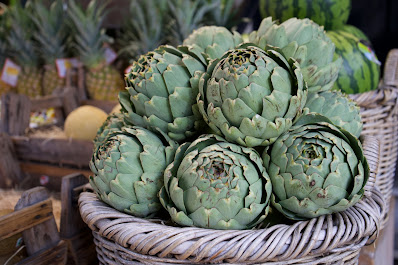Discovering the Benefits of Artichokes: A Guide to Nutrition and Cooking
Artichokes are a popular vegetable in Mediterranean cuisine, with a distinctive shape and taste. They are part of the thistle family, and their scientific name is Cynara scolymus. Artichokes have been cultivated for centuries, and have been used both as a food and a medicinal plant.
Health Benefits of Artichokes
Artichokes are not only tasty, but also offer a variety of health benefits. Here are some of the key benefits of consuming artichokes: 1. Rich in Antioxidants and Nutrients
Artichokes are a good source of antioxidants, such as vitamin C, vitamin E, and phytochemicals. These substances can help protect the body from damage caused by free radicals, which are unstable molecules that can cause cell damage and increase the risk of chronic diseases.
Artichokes are also a rich source of fiber, which can promote digestive health and help regulate blood sugar levels. Additionally, artichokes contain several essential vitamins and minerals, including folate, magnesium, potassium, and iron. 2. May Promote Liver and Digestive Health
Artichokes contain compounds that may have a positive effect on liver and digestive health. For example, some studies have suggested that artichokes can help increase bile production, which can aid in the digestion and absorption of fats.
Artichokes also contain compounds that may have a protective effect on the liver. For example, a study in rats found that artichoke extract was able to reduce the amount of oxidative stress in the liver, which is a key factor in the development of liver disease. 3. May Help Lower Cholesterol Levels and Reduce the Risk of Heart Disease
Artichokes may help lower cholesterol levels, which can reduce the risk of heart disease. This is because artichokes contain compounds that can inhibit the production of cholesterol in the liver, and may also increase the excretion of cholesterol from the body.
One study found that supplementing with artichoke extract was able to reduce total cholesterol levels by 18.5%, and LDL ("bad") cholesterol by 22.9%. Other studies have suggested that consuming artichokes may also help improve other risk factors for heart disease, such as blood pressure and inflammation.
How to Select and Store Artichokes
When selecting artichokes, look for those that are firm, heavy, and have tightly closed leaves. The color of the artichoke should be a deep green, and the leaves should squeak when pressed together. Avoid artichokes that have brown spots, loose or open leaves, or have a mushy texture.
To store artichokes, place them in a plastic bag and store them in the refrigerator for up to a week. Alternatively, you can place the artichokes in a bowl of water with a few drops of lemon juice to help prevent browning and maintain freshness.
How to Prepare Artichokes for Cooking
Preparing artichokes for cooking can be a bit intimidating at first, but with a bit of practice, it can become quite simple. Here is a step-by-step guide on how to clean and trim artichokes:
Begin by cutting off the top quarter of the artichoke with a sharp knife. Use a pair of kitchen scissors to snip off the thorny tips of the leaves.
Use a vegetable peeler to remove the tough outer layer of the stem.
Cut off the bottom inch of the stem, then trim away any remaining tough parts with a knife.
Use a pair of kitchen shears to snip off the top 1/4 inch of each of them.
Spread the leaves apart and rinse the artichoke under running water to remove any dirt or debris.If you are planning to stuff the artichoke, use a spoon to gently scoop out the fuzzy choke from the center of the artichoke.
If you are cooking the artichoke whole, fill a large pot with enough water to cover the artichokes, and bring the water to a boil. Add the artichokes to the pot and boil them for about 30-40 minutes, or until the leaves can be easily pulled off.
If you are grilling or roasting the artichokes, brush them with olive oil and season them with salt and pepper. Grill or roast them until they are tender and lightly browned.
Culinary Uses of Artichokes
Artichokes are a versatile vegetable that can be used in a variety of dishes. Here are some popular culinary uses of artichokes:
Artichoke Dip: This classic appetizer is made by blending artichoke hearts with cream cheese, mayonnaise, garlic, and other seasonings. It can be served hot or cold with crackers, bread, or vegetable sticks.
Stuffed Artichokes: This is a popular Italian dish in which the artichoke is filled with a mixture of breadcrumbs, cheese, garlic, and herbs, then baked until tender.
Grilled Artichokes: Grilling artichokes gives them a smoky flavor and a crispy texture. Simply brush them with olive oil and seasonings, then grill them until they are lightly charred.
Artichoke and Spinach Quiche: Artichokes pair well with spinach and eggs, making them a great addition to quiche. Simply mix together eggs, milk, cheese, spinach, and artichokes, then bake in a pie crust.
Artichoke and Tomato Pasta: This simple and flavorful pasta dish is made by sautéing garlic, onion, and artichokes in olive oil, then tossing them with cooked pasta and diced tomatoes.
Recipes Featuring Artichokes
Here are a few recipes that feature artichokes as a main ingredient: Spinach and Artichoke Dip:
1 can of artichoke hearts, drained and chopped
1 package of frozen spinach, thawed and drained
1 cup of cream cheese, softened
1/2 cup of mayonnaise
1/2 cup of grated Parmesan cheese
1/4 cup of chopped onion
2 cloves of garlic, minced
Salt and pepper to taste
Mix together all the ingredients in a bowl, then transfer to an oven-safe dish. Bake at 350 degrees for 20-25 minutes, or until the dip is bubbly and lightly browned on top. Grilled Artichokes with Lemon-Garlic Butter:
4 artichokes
1/2 cup of olive oil
3 cloves of garlic, minced
2 tablespoons of lemon juice
Salt and pepper to taste
Mix together the olive oil, garlic, lemon juice, salt, and pepper in a bowl. Brush the artichokes with the mixture, then grill them over medium heat for about 30-40 minutes, or until they are tender. Serve with additional lemon-garlic butter on the side. Artichoke and Tomato Pasta:
1 pound of pasta
2 tablespoons of olive oil
2 cloves of garlic, minced
1 can of diced tomatoes
1 can of artichoke hearts, drained and chopped
Salt and pepper to taste
Cook the pasta according to package instructions. While the pasta cooks, heat the olive oil in a pan over medium heat. Add the garlic and cook for 1-2 minutes, or until fragrant. Add the diced tomatoes and artichoke hearts to the pan and cook for an additional 5-7 minutes, or until the tomatoes are soft and the artichokes are heated through. Season with salt and pepper to taste. Once the pasta is cooked, drain it and add it to the pan with the tomato and artichoke sauce. Toss to combine, then serve hot.
Health Benefits of Artichokes
In addition to their delicious taste, artichokes are also packed with nutrients and health benefits. Here are a few reasons why you should consider adding artichokes to your diet:
High in Fiber: Artichokes are a great source of dietary fiber, which can help regulate digestion and promote feelings of fullness.
Loaded with Antioxidants: Artichokes contain high levels of antioxidants, which can help protect your cells from damage caused by free radicals.
May Help Lower Cholesterol: Some studies have shown that artichokes may help reduce levels of LDL (bad) cholesterol in the blood.
Good for Liver Health: Artichokes contain compounds that may help protect and support liver function.
May Improve Digestive Health: The fiber and prebiotic compounds in artichokes can help feed the good bacteria in your gut, which can promote digestive health.
Overall, artichokes are a delicious and nutritious vegetable that can be enjoyed in a variety of ways. Whether you prefer them grilled, roasted, stuffed, or pureed into a dip, artichokes are a great addition to any meal. So next time you're at the grocery store, be sure to pick up a few artichokes and give them a try!
Tips for Buying and Preparing Artichokes
When shopping for artichokes, look for ones that are firm and heavy for their size, with tightly closed leaves. The stem should also be fresh and firm, not dried out. Once you have your artichokes, you'll need to prepare them before cooking. Here's how:
Rinse the artichokes under cool water, then pat them dry.
Using a sharp knife, cut off the top inch or so of the artichoke to remove the prickly tips of the leaves.
Trim the stem, leaving about an inch attached to the base of the artichoke.
Using kitchen shears, trim the tips of the outer leaves to remove the thorny tips.
- Cut the artichoke in half lengthwise and use a spoon to scoop out the fuzzy choke in the center of the artichoke.
Once your artichokes are prepped, you're ready to cook them in your favorite recipe!
Final Thoughts
Artichokes are a versatile and healthy vegetable that can add flavor and nutrition to your meals. Whether you're cooking up a classic stuffed artichoke, enjoying a simple grilled artichoke, or adding artichoke hearts to a pasta dish, you're sure to appreciate the unique flavor and texture that this vegetable has to offer. So don't be afraid to get creative in the kitchen and try out new artichoke recipes – your taste buds and your body will thank you!








0 Comments